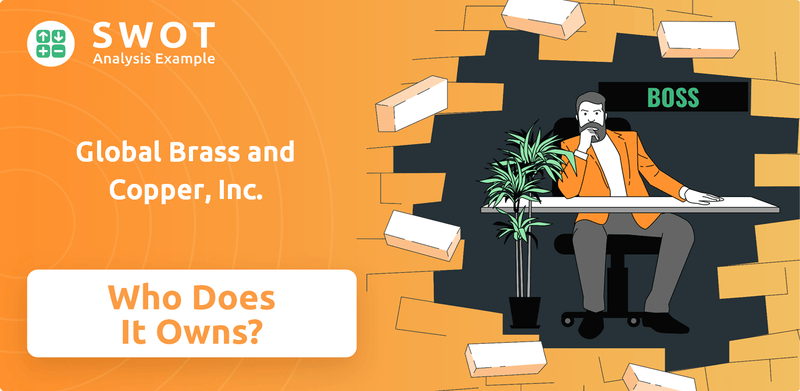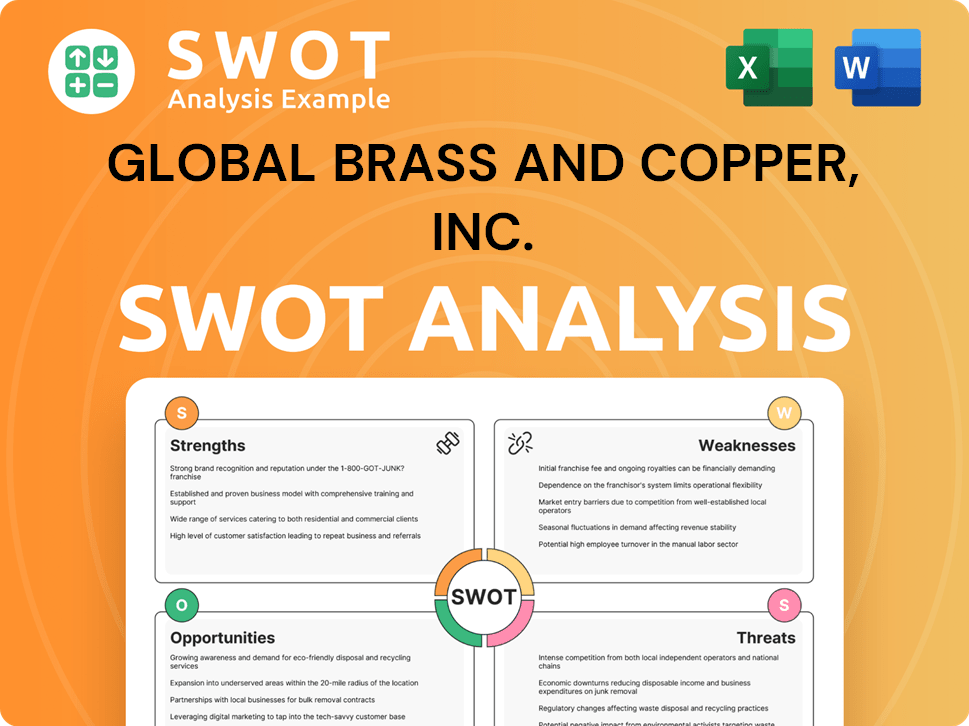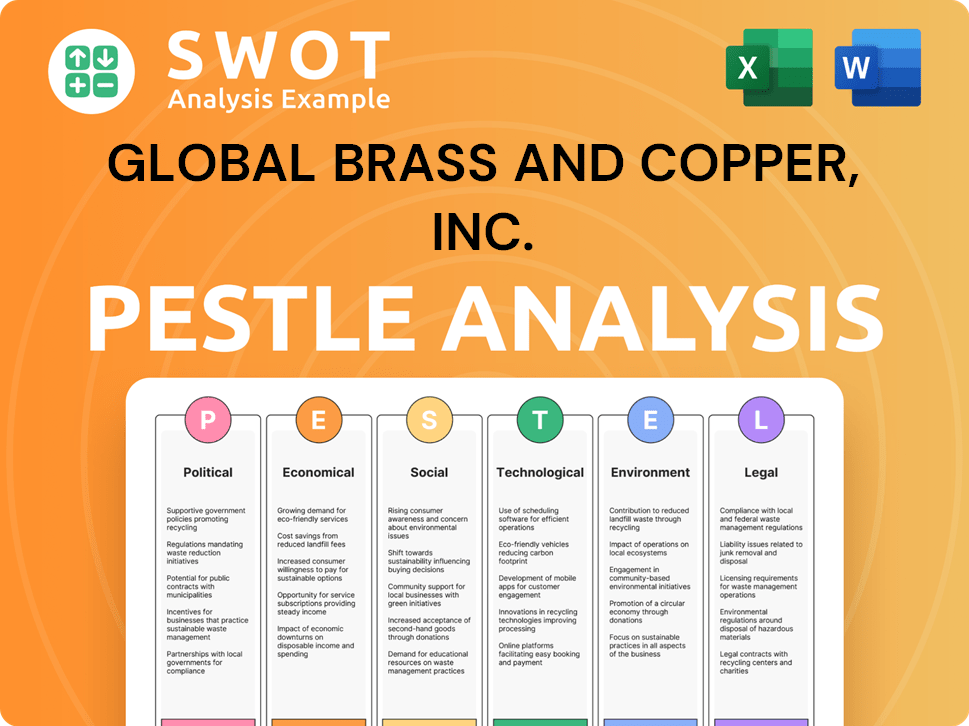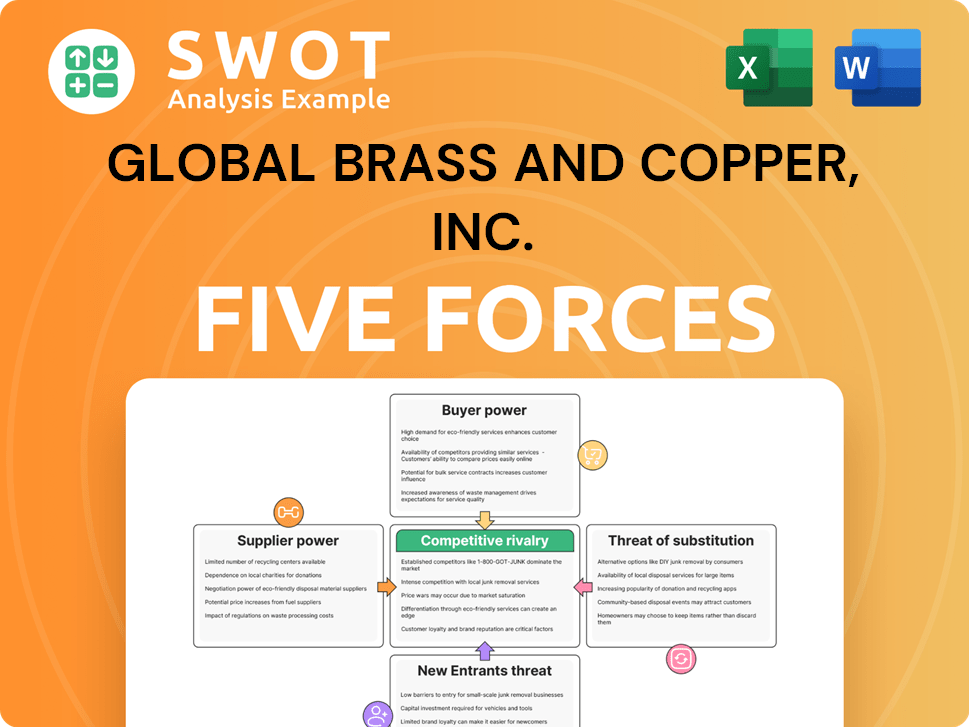Global Brass and Copper, Inc. Bundle
Who Really Owns Global Brass and Copper?
Ever wondered about the ownership behind the global metals giant, Global Brass and Copper (GBC)? This company, a key player in non-ferrous metals, underwent a significant transformation. Understanding the Global Brass and Copper, Inc. SWOT Analysis is crucial for grasping its strategic positioning.

The acquisition of GBC by Wieland-Werke AG reshaped the industry, transitioning GBC from a publicly traded entity to a wholly-owned subsidiary. This shift in GBC ownership has implications for its strategic direction and market position. This report explores the details of the GBC company's ownership, its history, and the impact of this change on its stakeholders, providing insights into who owns GBC and the broader implications for the industry.
Who Founded Global Brass and Copper, Inc.?
The genesis of Global Brass and Copper Holdings, Inc. (GBC) traces back to the acquisition of Olin Corporation's global metals business on November 19, 2007. Unlike companies with individual founders, GBC emerged as a separate entity through this strategic acquisition. The early ownership structure of the GBC company was primarily shaped by KPS Capital Partners, LP (KPS), which played a pivotal role in its initial development.
KPS, through its affiliated management entities and KPS Special Situations Funds, became the majority shareholder. This ownership structure was solidified after a recapitalization in August 2010. This recapitalization was a key event, demonstrating KPS's significant commitment and strategic financial structuring to support GBC's growth.
John H. Walker, who served as CEO of GBC from 2007, provided crucial leadership during this formative period. His role was instrumental in navigating the company's early stages. The decisions made, including the recapitalization and KPS's ongoing support, were aimed at ensuring GBC remained conservatively capitalized while pursuing its growth initiatives.
GBC was formed after acquiring Olin Corporation's metals business. This acquisition was a pivotal moment in the company's history. The formation marked the beginning of GBC as a standalone entity.
KPS Capital Partners, LP (KPS) was the primary early owner of GBC. KPS, along with its affiliated entities, held a majority stake. This ownership structure provided the financial backing needed for GBC's initial operations.
A significant recapitalization occurred in August 2010. This involved raising $465 million in new financing. The recapitalization helped to refinance debt and support growth.
The $465 million in new financing included a $150 million revolving credit facility. Also included was a $315 million term loan. These funds were crucial for GBC's financial stability and expansion.
John H. Walker served as CEO of GBC starting in 2007. His leadership was important during the company's early years. Walker's role was crucial for GBC's strategic direction.
Early agreements focused on conservative capitalization and growth. The aim was to ensure GBC's financial health. These strategies helped GBC to pursue its business goals.
The early ownership of Global Brass and Copper, or GBC, was heavily influenced by KPS Capital Partners. The recapitalization in 2010, which involved raising $465 million, demonstrates KPS's commitment. This financial structuring, along with the leadership of John H. Walker, set the stage for GBC's future. For more insights into the competitive landscape surrounding GBC, you can refer to Competitors Landscape of Global Brass and Copper, Inc.
Global Brass and Copper, Inc. SWOT Analysis
- Complete SWOT Breakdown
- Fully Customizable
- Editable in Excel & Word
- Professional Formatting
- Investor-Ready Format

How Has Global Brass and Copper, Inc.’s Ownership Changed Over Time?
The ownership of Global Brass and Copper (GBC) has seen significant changes since its inception. Initially, KPS Capital Partners and GBC management primarily owned the company after its formation in 2007 through the acquisition of Olin Corporation's metals business. This structure set the stage for future developments in GBC ownership.
A pivotal moment came in 2013 when Global Brass and Copper went public on the NYSE under the ticker BRSS, opening up shareholding to the public. The most transformative event occurred in 2019 when Wieland-Werke AG acquired all outstanding shares of GBC in an all-cash deal valued at approximately $999 million, with shareholders receiving $44.00 per share. This acquisition led to GBC becoming a wholly-owned subsidiary of the Wieland Group, and its shares were delisted from the New York Stock Exchange.
| Event | Date | Impact |
|---|---|---|
| Formation | 2007 | Acquisition of Olin Corporation's metals business by KPS Capital Partners, establishing initial ownership. |
| IPO | 2013 | GBC became publicly traded on the NYSE, expanding the shareholder base. |
| Acquisition by Wieland | 2019 | Wieland-Werke AG acquired GBC, making it a wholly-owned subsidiary and delisting it from the NYSE. |
Currently, the Wieland Group is the major stakeholder of Global Brass and Copper, Inc. This acquisition has integrated GBC's North American operations into Wieland's global network, solidifying its position in the red metals industry. For more insights into the company's financial aspects, you can explore the Revenue Streams & Business Model of Global Brass and Copper, Inc.
The ownership of Global Brass and Copper has evolved significantly over time, from private equity to public trading and finally, to acquisition by Wieland Group.
- KPS Capital Partners initially owned GBC.
- GBC went public in 2013.
- Wieland acquired GBC in 2019, making it a subsidiary.
- Wieland Group is the current parent company.
Global Brass and Copper, Inc. PESTLE Analysis
- Covers All 6 PESTLE Categories
- No Research Needed – Save Hours of Work
- Built by Experts, Trusted by Consultants
- Instant Download, Ready to Use
- 100% Editable, Fully Customizable

Who Sits on Global Brass and Copper, Inc.’s Board?
Before being acquired, the GBC company had a publicly listed board of directors. In 2013, the board included members such as John Walker, who was the Chief Executive Officer and later became Executive Chairman of the Board, and Michael Psaros, who remained on the board after stepping down as Chairman. Other board members included Peter C. Browning, Clayton C. Daley, Jr., Daniel R. DiMicco, Harvey B. Gantt, Victoria F. Haynes, James D. Hlavacek, and Bernard L. Kasriel. These individuals represented a mix of executive leadership, independent directors, and those associated with investment firms like KPS Capital Partners, a majority shareholder.
Following the merger in the second half of 2019, Global Brass and Copper Holdings, Inc. became a wholly-owned subsidiary of the Wieland Group. As a result, the independent board of directors was dissolved or integrated into Wieland's corporate governance structure. The current ownership structure places control and voting power within the Wieland Group's overall governance. Strategic decisions are now made at the parent company level.
| Board Member | Role | Affiliation |
|---|---|---|
| John Walker | Former CEO and Executive Chairman | GBC |
| Michael Psaros | Former Chairman and Board Member | GBC |
| Peter C. Browning | Board Member | GBC |
The acquisition by Wieland Group in 2019 changed the GBC ownership structure. Wieland-Werke AG, a German stock corporation, has a Supervisory Board overseeing the Executive Board. The Supervisory Board consists of 12 members, with six elected by the Annual General Meeting and six by the workforce. The Executive Board is responsible for the company's sustainability strategy, with the Supervisory Board informed and setting targets. For more details on the company's history, you can read this article about Global Brass and Copper, Inc.
The GBC company's board structure evolved after its acquisition by the Wieland Group. The current structure reflects Wieland's governance, with strategic decisions made at the parent company level.
- Prior to 2019, GBC had an independent board.
- Wieland Group now controls the company.
- The Supervisory Board oversees the Executive Board.
- Strategic decisions are made at the parent company level.
Global Brass and Copper, Inc. Business Model Canvas
- Complete 9-Block Business Model Canvas
- Effortlessly Communicate Your Business Strategy
- Investor-Ready BMC Format
- 100% Editable and Customizable
- Clear and Structured Layout

What Recent Changes Have Shaped Global Brass and Copper, Inc.’s Ownership Landscape?
Since the acquisition in the latter half of 2019, the GBC company, now operating as part of Wieland North America, has been fully integrated into Wieland's global operations. This integration created a leading player in the red metals industry. The combined entity now has a network of over 90 facilities and approximately 9,000 employees worldwide. Wieland Group reported over 10,000 employees globally as of September 30, 2024.
Recent developments within the Wieland Group highlight continued strategic investments. In March 2025, Wieland began construction of a $500 million hot rolling mill in the United States. This investment, expected to be completed by mid-2028, strengthens Wieland's North American presence. In October 2024, Wieland finalized the acquisition of Onda S.p.A. to bolster its participation in growing markets. These moves reflect industry trends towards consolidation and diversification.
| Metric | Value | Year |
|---|---|---|
| Global Brass Market Value | USD 8.75 billion | 2024 |
| Projected Global Brass Market Value | USD 21.08 billion | 2033 |
| CAGR of Global Brass Market | 10.26% | 2024-2033 |
| Copper and Brass Flat Products Market Value | USD 110.8 billion | 2024 |
| Estimated CAGR of Copper and Brass Flat Products Market | Over 7.6% | 2025-2034 |
The current ownership structure under Wieland provides Global Brass and Copper with greater resources and a global network, enabling it to capitalize on industry trends. The automotive and electronics industries are driving increased demand, providing a favorable environment for Wieland's expanded operations. Learn more about the Marketing Strategy of Global Brass and Copper, Inc.
GBC ownership is now fully integrated within the Wieland Group. This structure provides access to greater resources and a global network.
The global brass market was valued at USD 8.75 billion in 2024 and is projected to reach USD 21.08 billion by 2033, growing at a CAGR of 10.26%. The copper and brass flat products market was valued at USD 110.8 billion in 2024.
Wieland commenced construction of a $500 million hot rolling mill in the United States in March 2025. In October 2024, Wieland finalized its acquisition of Onda S.p.A.
The increasing demand from automotive and electronics industries provides a favorable environment for Wieland's expanded operations. The company is well-positioned to capitalize on these trends.
Global Brass and Copper, Inc. Porter's Five Forces Analysis
- Covers All 5 Competitive Forces in Detail
- Structured for Consultants, Students, and Founders
- 100% Editable in Microsoft Word & Excel
- Instant Digital Download – Use Immediately
- Compatible with Mac & PC – Fully Unlocked

Related Blogs
- What are Mission Vision & Core Values of Global Brass and Copper, Inc. Company?
- What is Competitive Landscape of Global Brass and Copper, Inc. Company?
- What is Growth Strategy and Future Prospects of Global Brass and Copper, Inc. Company?
- How Does Global Brass and Copper, Inc. Company Work?
- What is Sales and Marketing Strategy of Global Brass and Copper, Inc. Company?
- What is Brief History of Global Brass and Copper, Inc. Company?
- What is Customer Demographics and Target Market of Global Brass and Copper, Inc. Company?
Disclaimer
All information, articles, and product details provided on this website are for general informational and educational purposes only. We do not claim any ownership over, nor do we intend to infringe upon, any trademarks, copyrights, logos, brand names, or other intellectual property mentioned or depicted on this site. Such intellectual property remains the property of its respective owners, and any references here are made solely for identification or informational purposes, without implying any affiliation, endorsement, or partnership.
We make no representations or warranties, express or implied, regarding the accuracy, completeness, or suitability of any content or products presented. Nothing on this website should be construed as legal, tax, investment, financial, medical, or other professional advice. In addition, no part of this site—including articles or product references—constitutes a solicitation, recommendation, endorsement, advertisement, or offer to buy or sell any securities, franchises, or other financial instruments, particularly in jurisdictions where such activity would be unlawful.
All content is of a general nature and may not address the specific circumstances of any individual or entity. It is not a substitute for professional advice or services. Any actions you take based on the information provided here are strictly at your own risk. You accept full responsibility for any decisions or outcomes arising from your use of this website and agree to release us from any liability in connection with your use of, or reliance upon, the content or products found herein.